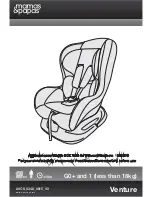
31
TO BE USED WITH A LAP SASH OR LAP ONLY SEATBELT IN THE BACK OF MOST CARS WITH
FORWARD FACING SEATS.
Once the child's shoulders reach the lower shoulder height marker then the seat can be changed to the
forward facing position and used until the child's shoulders reach the upper shoulder height marker.
Continue to use this restraint in this forward facing mode until the child's shoulders reaches the limit
of the lower shoulder height marker. The child should not sit forward facing until their neck muscles
are able to support their head. Do not move to a Booster Seat until the child has outgrown this child
restraint.
Regional Road Rules may prohibit the use of this restraint in the front seat of the vehicle until the child
is 4 years of age. Check your Regional Road Rules for exemptions.
DO NOT USE RESTRAINT IN FORWARD-FACING MODE WITH THE REAR FACING MODE
STABILISING BAR PULLED OUT.
Do not use the restraint without the Upper Anchorage Strap correctly attached.
If your vehicle is not fitted with an anchor point, please contact a Safety Restraint Fitting Station
authorised by the relevant State Government Body for correct fitment of the restraint. In New Zealand
contact the agent for the vehicle. The upper anchorage strap must be attached to an anchorage point
using an extension strap if necessary.
Do not use on any vehicle seat which faces sideways or rearwards.
Do not use the Insert Pad (if fitted) in Forward Facing mode.
If an airbag is fitted in the desired seating position where the child restraint is fitted, follow the vehicle
manufacturer's warnings and instructions.
Children are of risk of serious injury if they move to a booster seat too early.
SUITABLE FOR USE
FORW
ARD F
ACING
















































